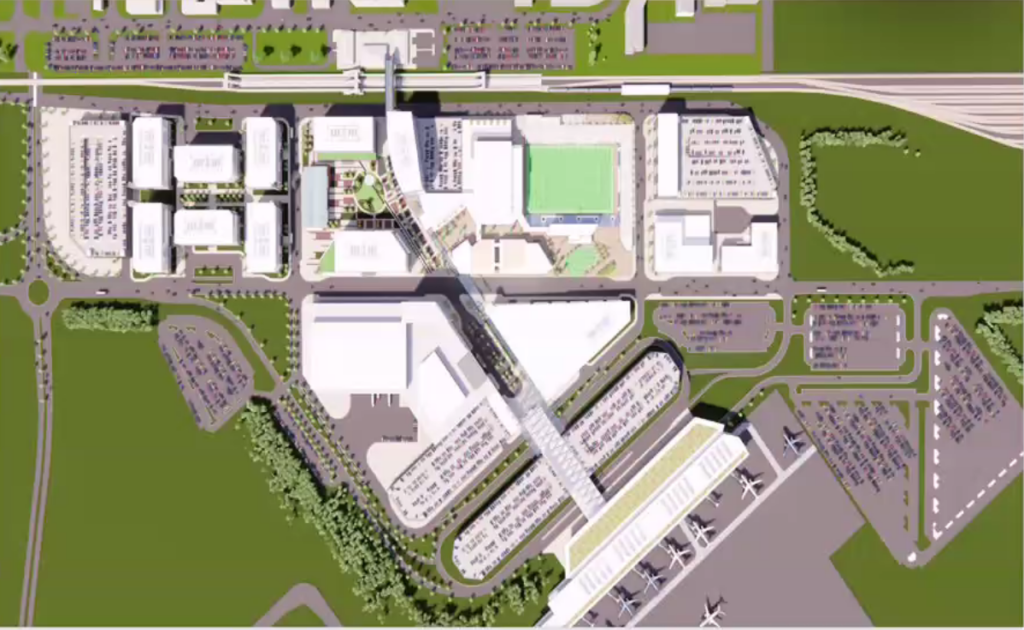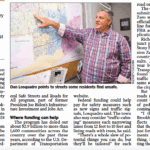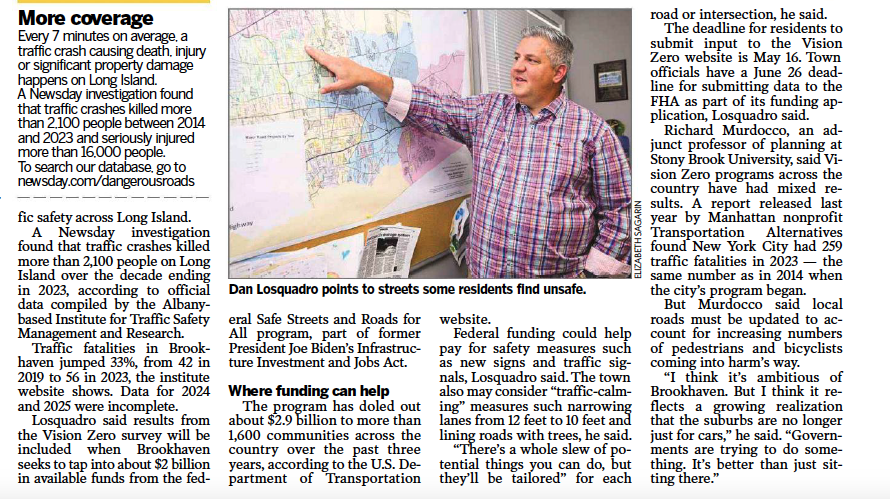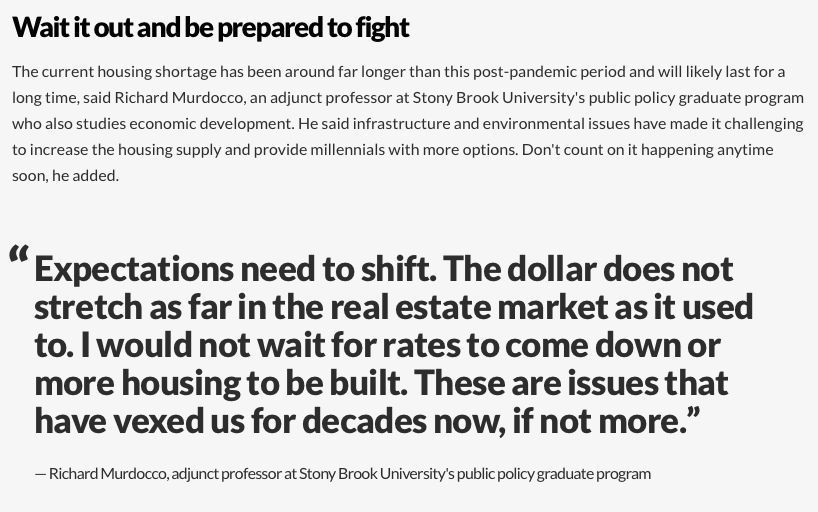The following was exclusively published by The Foggiest Idea on May 15th, 2022. Interested in supporting The Foggiest Idea’s award-winning reporting and analysis? Click here.
BY RICHARD MURDOCCO
If developers have their way, the empty swath of land near the Ronkonkoma Long Island Rail Road Station would become the site of a $2.8 billion Midway Crossing development complete with a new convention center, a 300-room hotel, a venue for indoor and outdoor events, a life sciences complex, and so much more.
But there’s a catch the size of a Boeing 747.
During a virtual public hearing that the Long Island Regional Planning Council held late last week, representatives of JLL, the Chicago-based developer also known as Jones Lang LaSalle which is pushing the ambitious project, admitted that the Town of Islip would have to work successfully with New York State and federal agencies including the Federal Aviation Administration to secure significant investment dollars to fund the creation of a new northern terminal at Long Island MacArthur Airport before the project could actually take off.
According to JLL, the convention center would occupy 640,000 square feet, and the events venue would offer 9,000 seats. Paired with the life sciences component that could employ an estimated 4,300 people, builders are calling for the creation of 250,000 square feet of retail to, in their words, “anchor community engagement and service the on-site population.”
Housing is not on the table given that East Setauket-based TRITEC is constructing 1,500 or so units nearby.
But it all depends on what happens with the airport where development efforts have been stuck on the tarmac.
Late last year, Newsday reported that a $2.3 billion, 15-year redevelopment plan was in the works at the MacArthur Airport that envisioned the construction of a long-sought air terminal connecting the airport and the Ronkonkoma Long Island Rail Road station.
Local sources told reporters at the time, however, that plans for the airport faced “numerous logistical hurdles, ranging from financing and questions about its impact on traffic and sewers to relocating an Islip Town composting facility that sits on land that would be part of the development.”
Aside from the local issues at play, any new air terminal would require approval from the Federal Aviation Administration, an entity not known for its expeditious review.
While representatives from the Town of Islip were present on the virtual call on JLL’s latest proposal for Ronkonkoma, they opted to not weigh in, despite an extended question and answer session. The airport sits on land that is owned by Islip Town and Suffolk County.
“Our goal is to help and support the town so that they are successful,” noted Derek Trulson, JLL vice chairman, in response to The Foggiest Idea’s question during the public hearing about the airport’s role in relation to Midway’s success. Trulson explained that securing an expanded terminal that links to the LIRR is key to Midway Crossing, and one can’t happen without the other. “It’s all or none.”

PICTURED: The master site plan for the $2.8 billion Midway Crossing in Ronkonkoma. Project backers argue that a new northern terminal at MacArthur Airport is needed. (Source: JLL)
Those keeping track of attempts to develop the Ronkonkoma Hub in recent years may recall that previous efforts had included a minor league hockey arena, office buildings and the like.
In 2019, when The Foggiest Idea explored the viability of the convention center portion of the project, various local officials expressed their skepticism. A year before, on the pages of Newsday, TFI chided Suffolk County for its lack of transparency related to redevelopment efforts at the location.
Since then, the project has been further fine-tuned. The latest upscale renderings highlight a new approach to complement the convention venue pitch such as adding a dedicated life sciences complex that JLL said in its presentation would serve as a “catalyst for private investment, careers, and job growth.” A similar approach had been planned by Nassau County and the developer RXR for the vacant acres currently surrounding the Nassau Coliseum, but nothing has broken ground there.
If Midway Crossing does get built, the economic impact could be nearly $3 billion per year and create 9,300 permanent jobs, planners say. Paired with the shiny new 300,000-square-foot northern air terminal, JLL predicts that its project could make MacArthur airport home to 3 million passengers per year.
Such optimistic forecasts may certainly be rosy as many economists are ringing alarm bells about the domestic economy while the nation struggles to tame rampant inflation.
Nevertheless, providing new event venues remains a key component of JLL’s latest iteration of its proposal for Ronkonkoma despite the relatively successful opening of the USB Arena at Belmont Park and the subsequent struggles of the Nassau Coliseum to find acts to fill that space. Competition could be significant.
As previously reported by TFI, the number of conventions hosted in the U.S. has fallen over the last decade, while attendance at the 200 largest conventions has declined steadily since the 1990s.
During the public hearing, TFI asked about these public trends as well as the economic viability of a convention venue. Dr. Mark Rosentraub, the director of the Center for Sports Venues and Real Estate Development at the University of Michigan, who serves as a consultant to JLL, wasn’t worried.
“While you can talk about the competition, we’ve had other cities that have been extraordinarily successful,” Rosentraub noted, citing successful venues in Indianapolis as an example.

PICTURED: A rendering of a soccer match being held at Midway Crossing’s outdoor events venue. Nearby competition for such spaces includes the Nassau Coliseum, the USB Arena at Belmont Park, and other venues within New York City. (Source: JLL)
“We’re not going after the very large conventions, but going after a much smaller market,” Rosentraub explained, adding that consumer shows are a good niche for a Long Island venue to fill. “You have a market of roughly Queens, Nassau and Suffolk Counties, and the number of consumer shows is enough to have a great location that the market would be satisfied.”
JLL’s Trulson quickly jumped in to support the idea. “The other thing that’s critical is that it has to be multipurpose,” Trulson said, asserting that anything built at Midway Crossing would be “programmed to have event days beyond conventions and provide civic value to the community.”
Given the economic storm clouds gathering on the horizon, it was surprising to TFI not to hear any discussion from the Long Island Regional Council members and the developers of ways the development plan could blunt the impacts of rising inflation as well as the changing consumer behaviors in the post-COVID world.
Before the virtual meeting ended, the planning council voted 9-0 to designate Midway Crossing a project of regional significance, a move that was not surprising, given the proposed scale of the $2.8-billion proposal.
Hockey Hall of Famer Pat LaFontaine, who joined forces with JLL in 2019 to try to bring professional soccer and hockey to Suffolk County, stressed that the opportunity may be fleeting given the confluence of various pots of government money that may be made relatively available to what he called “such an amazing site.” To LaFontaine, the chance to do the project may never present itself again. “At the end of the day, we’re looking at our future.”
Whether or not that future includes a convention and events venue, as well as the other bells and whistles that JLL is touting, remains to be seen. While the plans are still evolving, much of the discussion may be premature given the up-in-the-air status of MacArthur Airport. Nothing can take off there without it. And if the planes aren’t flying, forget about it.
Richard Murdocco is an award-winning columnist and adjunct professor in Stony Brook University’s public policy graduate program and School of Atmospheric and Marine Sciences. He regularly writes and speaks about Long Island’s real estate development issues. Follow him on Twitter @thefoggiestidea.
You can email Murdocco at Rich@TheFoggiestIdea.org.












3 million passengers a year flying out of MacArthur! How many flights a day does that equal? I’m sure JLL executives find that number to be acceptable because they won’t be living under these flight paths and driving on already ridiculously crowded potholed roads. Please explain how this latest plan benefits those of us who live and pay taxes in Islip.